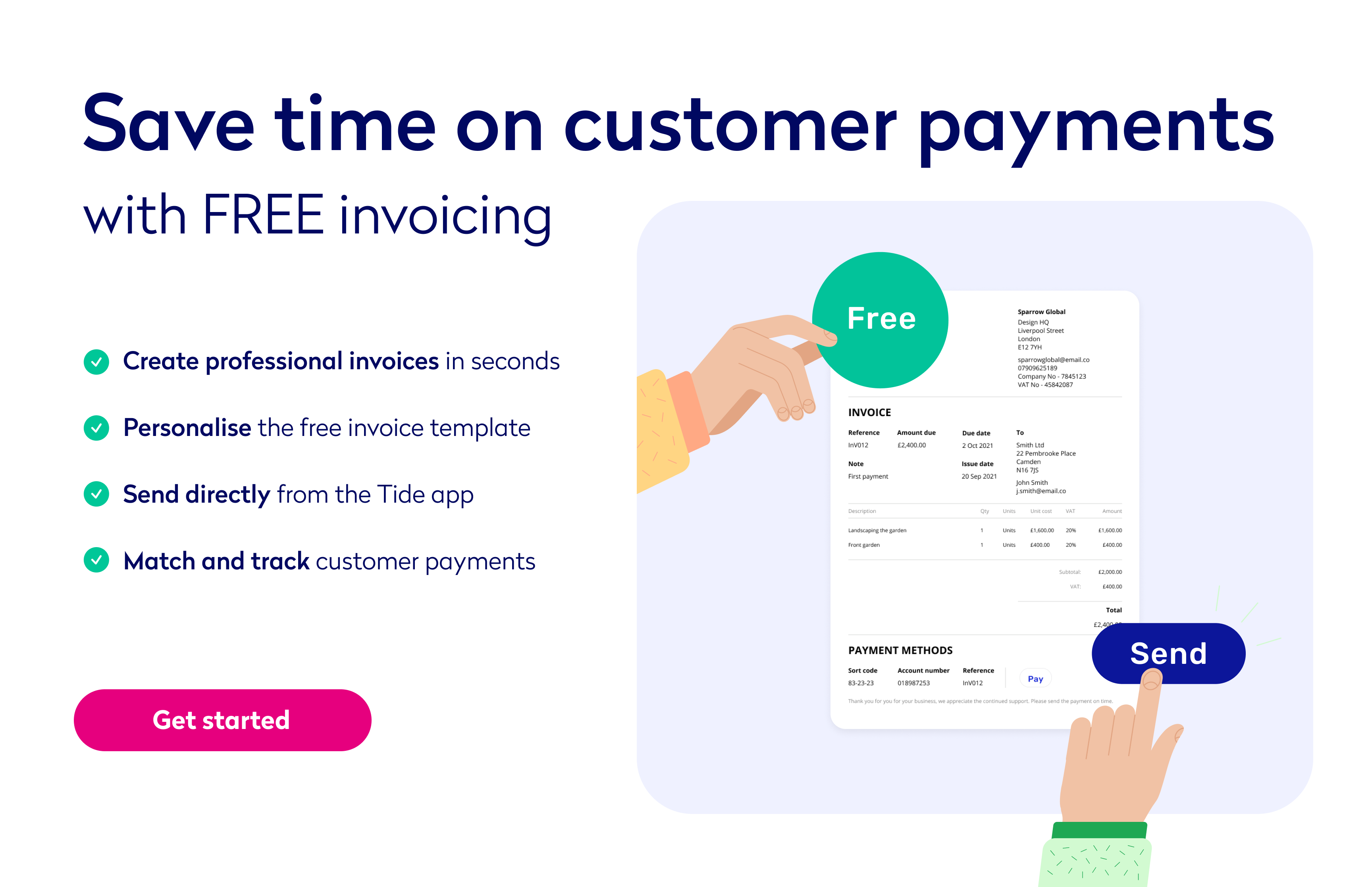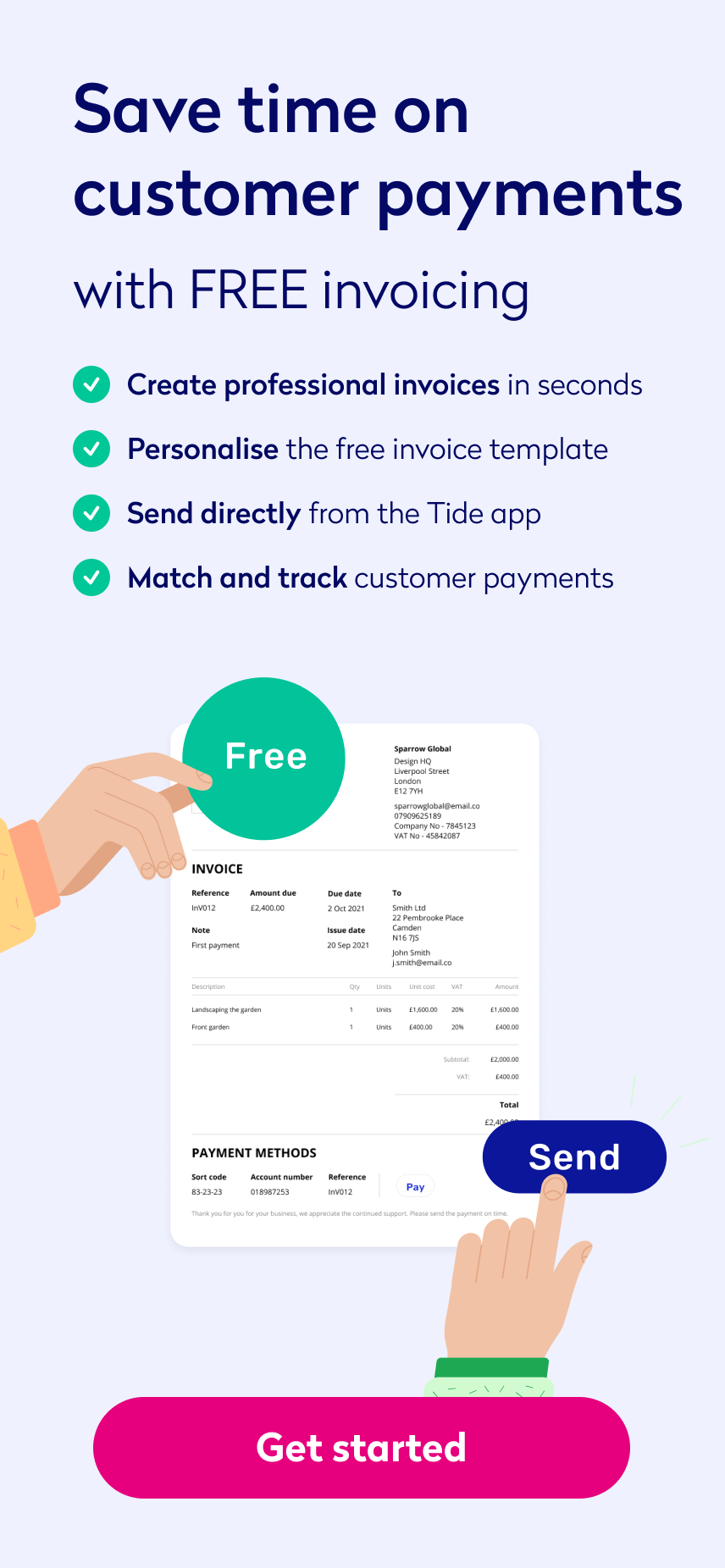
How to chase an overdue invoice (the right way)

You’ve delivered on your work, set your payment terms and sent an invoice to your client. But the payment is overdue, and you haven’t received a response or update.
Don’t worry—you’re not alone. We surveyed 1,000 CEOs, founders, directors and senior management staff at SMEs and found that the average UK SME is chasing five outstanding invoices at any one time. That amounts to an average of £8,500 being owed and 1.5 hours per day spent chasing late payments.
But no need to panic! There are several ways to manage an overdue invoice, no matter the state of your client relationship.
In this quick guide, we’ll cover how to get your invoices paid without burning client relationships and make sure you get paid fast.
Top Tip: Before we dive in, it’s important to understand the basics of creating an invoice in a way that incentivises prompt payments, as well as what common mistakes to avoid. To learn more, read our guide to raising an invoice and getting paid 💯
Table of contents
- Setting expectations & charging interest
- What to do when you’ve not been paid
- Email templates
- Seeking legal advice & mediation
- How long can you chase an invoice for?
- Ways to reduce invoice follow-up stress
- Expert insights
- Wrapping up


Setting expectations & charging interest
The best way to ensure any overdue invoices are paid is to set expectations from the beginning of your client relationships.
Start by outlining your payment terms from the first proposal you send to a client. When both parties are ready to sign a contract, there should be no surprises. Then, review these conditions during your kick-off calls and onboarding process.
When setting these expectations, make sure you cover the following:
- How you send your invoices
- How your client can pay you
- When you send invoices (i.e. day of the month)
- Payment terms (i.e. NET 15 for 15 days)
Make sure to have your “accounting house” in order, too. It can be hard to keep track if you’re constantly creating invoices manually and sending them via email every time. Instead, use an intelligent business account with integrated invoicing (such as Tide invoicing).
Top Tip: To see a list of the key features that an invoicing software solution should include, as well as our picks for the best solutions available on the market today, read our guide to the 11 best invoicing software solutions for your small business 🔥
You can also deter late payments by including interest terms in your agreement. The law allows you to do this, thanks to the Late Payment of Commercial Debts (Interest) Act 1998.
This legislation allows you to claim up to 8% interest on unpaid invoices. Just make sure you make this absolutely clear to your client when beginning your relationship.
Finally, make sure the information you include on your invoice is correct. Incorrect information can cause delays or disputes, so always ensure amounts, dates and client details are accurate before sending.
What to do when you’ve not been paid
You’ve sent your invoice, and the client has missed the payment date. The first important step is to keep calm. Sometimes, things slip through the cracks, and people forget. A friendly reminder might be all that’s needed.
Make sure that the first reminder is friendly. Remember, you don’t want to burn client relationships with harsh language. We’ll give you a template for this in the next section.
Don’t be too eager to follow up, either. If your payment terms are 30 days after receipt of invoice, don’t chase up on day 30; wait a few days and send that first reminder.
When reaching out, make sure you’re speaking to the right person. If the company you’re working with has an accounts receivable department, ask your contact if it would be appropriate to reach out to them directly. Remember to include a copy of the invoice in each email.
If email doesn’t work, pick up the phone to ask if your client received your previous emails. Ask them the following questions:
- Did you receive my last email about the overdue invoice? (quote the invoice number if necessary)
- Do you have any issues with the invoice that we can address while I’m on the phone?
- When do you think you can make the payment?
Always keep records of your correspondence (both via email and over the phone). Include who you talked to, the date and the time. This will be invaluable if you need to escalate things further. At some point, you may even need to hit “pause” on services rendered until the invoice is paid.
Email templates
Knowing how to communicate without burning your client relationships can be a delicate balance. Here, we share some templates you can use when chasing late payments.
1. Less than two weeks overdue
Subject line: Overdue payment ([YOUR COMPANY]) – [INVOICE REFERENCE]
Hi [CLIENT NAME],
I’m following up on invoice number [INVOICE REFERENCE]. It was due for payment on [INVOICE DUE DATE] and I wanted to confirm you received it?
I’ve attached the invoice to this email again for reference. Can you please confirm the invoice has been scheduled for payment?
Many thanks,
[YOUR NAME]
2. More than two weeks overdue
Subject line: Overdue payment ([YOUR COMPANY]) – [INVOICE REFERENCE]
Hi [CLIENT NAME],
Further to my previous email, I’m reaching out regarding outstanding invoice [INVOICE REFERENCE] / [INVOICE BALANCE].
As the invoice is overdue, can you please update the payment status? If there are any issues, such as missing information, please let me know and I’ll send over an amended invoice.
I’ve attached the invoice to this email for reference.
Thanks,
[YOUR NAME]
3. Interest warning (30 days or more)
Subject line: Overdue payment ([YOUR COMPANY]) – [INVOICE REFERENCE]
Hi [CLIENT NAME],
Further to my previous email, I’m contacting you again on behalf of [YOUR COMPANY] regarding outstanding invoice [INVOICE REFERENCE] / [INVOICE BALANCE].
To remind you, as per our service agreement, we are entitled to charge X% interest per [DAY/WEEK] of the invoice going unpaid. I’d love to avoid this, so please let me know if there are any issues. I’ve attached the invoice to this email again for convenience.
Thanks,
[YOUR NAME]
4. Final reminders (Extremely late invoices)
Subject line: Final reminder ([YOUR COMPANY]) – Invoice [INVOICE REFERENCE]
Hi [CLIENT NAME],
Further to my previous email, I’m contacting you on behalf of [YOUR COMPANY] regarding invoice [INVOICE REFERENCE] / [INVOICE AMOUNT DUE].
This invoice was due for payment on [DUE DATE] and remains unpaid.
As we’ve not heard from you, I’m afraid we will shortly begin legal proceedings to receive the amount owed to [YOUR COMPANY].
Immediate payment will result in us closing this issue without the need for legal action. I’ve attached a copy of the invoice to this email for convenience.
Thanks,
[YOUR NAME]
Seeking legal advice & mediation
The thought of seeking legal advice can seem overwhelming and perhaps unnecessary. However, when it comes to monies owed and the cash flow health of your business, it’s simply a part of doing business.
Here, we’ll cover three approaches you can choose depending on your situation. However, this is to be used as a point of reference only. We highly advise you to seek legal counsel from a professional solicitor before taking action.
Mediation
At the first stage, it’s best to get into a room to discuss the issue with your client and look for the best way to fix it.
This mediation process allows you both to discuss any miscommunication issues or address any internal problems head-on. It’s also much cheaper than legal proceedings.
You can learn more about mediation on the Civil Mediation Council’s website.
Statutory demand
A statutory demand is a formal, legal letter sent to the client, to which they have 21 days to respond. If the letter is ignored, you can take the client to court.
Ignoring a statutory demand carries serious risks, increasing a company’s chance of being liquidated. If you are being ignored, you can attempt to wind up a company if their debts are over £750. If you file a wind-up petition and a company ignores you, it will be listed in the Gazette and risks having its bank accounts closed and lines of credit denied.
In a more serious effort, you can apply to bankrupt a company if their debts are over £5,000. In both cases, you must be able to prove the company cannot pay their debt to you.
You can serve a statutory demand letter yourself, but be aware of the strict criteria required to uphold it. Again, we highly recommend seeking legal advice before following this route yourself.
Court action
If the invoice hasn’t been disputed throughout the entire process (including your invoice email follow-ups), you can take court action.
For claims under £100,000, follow the process online as outlined by the Justice Department. When going this route, you must prove sufficient communication between you and the client.
If the client disputes your claim, you may be required to attend court. Make sure you check out the Money Claim Online (MCOL) guide from HM Courts & Tribunal Service to ensure you’ve collected and provided all the correct information.
To begin this process, follow the process on Money Claim Online. Once again, make sure you seek legal advice before taking any action.
How long can you chase an invoice for?
According to the Limitation Act (1980), you can chase an unpaid invoice for up to six years after it was first issued. This includes any invoice payment follow-up you have done yourself and any legal proceedings issued against the client.
In some instances, clients may claim to have never received the goods or services or argue that they didn’t receive any payment reminders. For this reason, keep accurate records of your efforts to chase late payments. If a debt collection agency is involved, make sure you also have copies of those records.
Top Tip: Do you need extra help to improve your invoicing and avoid sending payment reminder emails? Read our guide for how to streamline your invoice process 📩
Ways to reduce invoice follow-up stress
Chasing unpaid invoices can be stressful and lead you down serious legal avenues. However, it is possible to spend less time worrying about getting paid and more time adding value to your business.
One way to reduce stress is by automating the email follow up process. Through your invoicing software, set up automatic emails to send every X number of days and let the system take care of the communication for you.
Alternatively, you can outsource the follow-up process to an invoice processing service rather than risking valuable time getting frustrated by unresponsive clients.
Through Tide Invoicing, you can also set up and personalise reminders to send to customers regarding outstanding invoices. Simply turn on the invoice chaser, choose a date for the follow-up and hit send. Once the invoice is paid, Tide will automatically match the incoming payment to your outstanding invoice and mark the invoice as paid.
Top Tip: We understand that running a business is stressful enough without worrying about chasing unpaid invoices and potentially pursuing legal action. That’s why we’ve come up with 5 ways to manage entrepreneurial stress and overwhelm ⌛
💡 Expert insights
Darren Fell is the CEO and Founder of Crunch, an award-winning online accounting service that supports freelancers, contractors, and practically anyone self-employed.
For over 10 years, Crunch has combined easy-to-use, online accounting software with real people, so that you’re always able to access your accounts and seek the support you need.
Crunch helps thousands of clients with their accounting needs every year, using their expertise and insight to help small business owners manage their responsibilities.
Q1: What advice would you give small business owners when setting payment expectations with clients?
Late payments can mean the difference between keeping the lights on or closing altogether, which is why you should always agree to a written contract with your client regarding the service being carried out or the product delivered. The contract should clearly outline payment expectations before you begin any work. Make sure you agree on what work is to be performed, what date it should be completed, and when and how you expect to be paid.
Once the work is complete, or if you’ve agreed to staged payments, make sure you’re being proactive. Issue a clear and accurate invoice that breaks down your services and explains how you’ve reached your overall fee. We recommend you use free accounting software to make this as simple as possible. Such software offers invoice templates and allows you to automate payment reminders to help make things even more efficient.
Make sure you know exactly who you need to send your invoice to; many businesses have been left chasing payments simply because they’ve sent their invoice to the wrong department!
Q2: What’s the best approach for chasing overdue invoices without burning relationships?
If you find yourself having to chase an unpaid invoice, establish a procedure: perhaps issue a polite automated reminder at first, which develops into a more formal phone call. Do this before advancing to stricter measures, such as charging your client late fees or statutory interest or calling in debt collectors if the issue begins to drag on. Remember, debt recovery is the nuclear option. Don’t dive for the debt collectors at the first sign of trouble, or you’ll start to develop a reputation.
Of course, an ounce of prevention is worth a pound of cure, so don’t forget to outline what steps you’ll take to chase late payers before you begin working with clients. Clearly explain the steps they can expect you to take if they don’t pay on time and that these actions are your standard practice, nothing personal!


Wrapping up
Getting paid on time and chasing overdue invoices is much easier if you set expectations in advance. Make your payment terms and invoicing process clear during your onboarding process.
When first following up on invoices, wait a few days before reaching out. Remember, things can slip through the cracks, so a friendly invoice reminder is usually all it takes. If you need to remind them further, use the email templates provided in this guide or set up automated invoice chasing through Tide.
And while legal action is sometimes needed, it’s unlikely you’ll need to go down this route. The key is to be armed with the correct information and prepared for any situation.
Photo by Bruce Mars, published on Pexels






